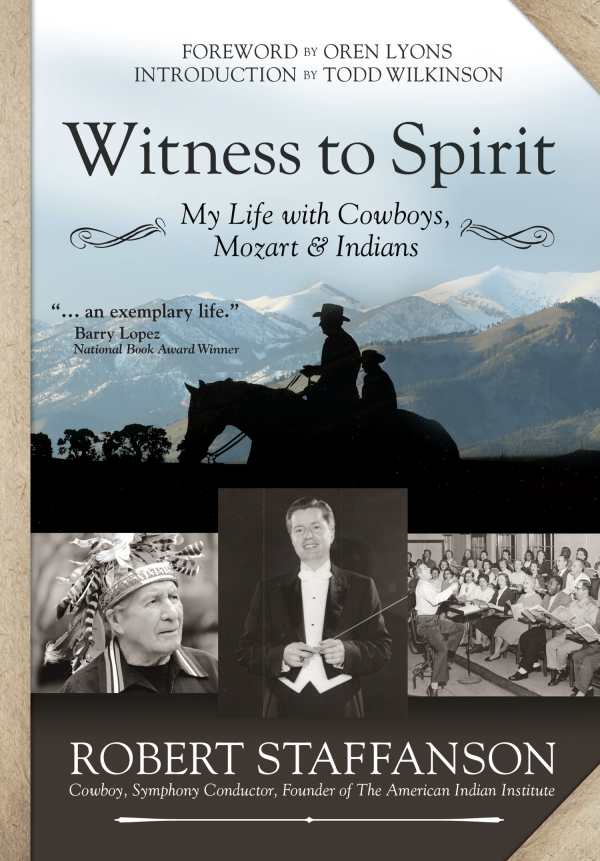It looks like you've stumbled upon a page meant to be read by our code instead of viewed directly. You're probably looking for this page.
Witness to Spirit
My Life with Cowboys, Mozart and Indians
Robert Staffanson recounts a unique life of music and spirit, from the conductor’s baton to Native American rights.
In the resonant memoir Witness to Spirit: My Life with Cowboys, Mozart and Indians, Robert Staffanson recounts his journey from a Montana childhood to conducting Massachusetts’s Springfield Orchestra. A life path leading from western landscapes to a conductor’s podium in New England seems remarkable enough, until Staffanson adds an unexpected movement to his personal musical score—his work as an advocate for Native Americans and as a cofounder of the American Indian Institute.
Born in 1921, Staffanson grew up on his parents’ ranch. He writes of long winters without electricity or plumbing, and how the trip into town for school was made by sleigh or riding horseback through subzero winds. His tone is that of the true pioneer—more matter-of-fact than melodramatic—with warmer memories of his mother’s love of music and books. Staffanson’s father played the fiddle and was a man of distinct moral character. Within this framework, Staffanson developed a perceptive resilience that would serve him well.
Staffanson also recalls being raised with a respect for nature and the cycles of the earth. An underlying current of individual destiny runs through Witness to Spirit, such as how even as a teenager Staffanson sensed that music would become a guiding force in his life and his “years in ranching were limited.” This force led Staffanson to earn a degree in music and later bring together Montana’s first symphony orchestra in Billings. He then received a serendipitous invitation to a Philadelphia conductors’ symposium, sponsored by the famed conductor Eugene Ormandy. One opportunity followed another—namely, Staffanson was chosen as conductor of the Springfield Orchestra in 1955, a position he would hold for more than a decade.
Staffanson and his wife, Anne, became part of their East Coast cultural hub yet still continued to enjoy summers in Montana. Staffanson effectively expresses the sense of confinement he felt while living in Massachusetts, a dissatisfaction that eventually compelled him to pursue a new spiritual quest. After much soul-searching and a severe illness that nearly left him deaf, Staffanson decided to take up the cause of Native American civil rights.
The section titled “Third Movement: Indians” is thoughtful yet truthful, without immediate feel-good solutions. Staffanson felt much compassion for Native American people and details how their heritage and sense of pride had been ravaged. He notes that while his empathy prompted initial mistrust and even contempt from both sides of the long-standing American vs. Indian fence, there were also moments of revelation and community. Staffanson’s realistic narrative regarding this peace-building work shows how true, long-term commitment is needed in any human rights endeavors.
Witness to Spirit sagely concludes that the integration of energies is key to preserving our past and preparing for a better future. Now in his nineties, the former “cowboy conductor” advises that spirit is essential to connection between all peoples, and that we should pay less attention to “the drum beat of commerce telling us that materialism is the highest goal” and follow a more universal rhythm.
Reviewed by
Meg Nola
Disclosure: This article is not an endorsement, but a review. The publisher of this book provided free copies of the book and paid a small fee to have their book reviewed by a professional reviewer. Foreword Reviews and Clarion Reviews make no guarantee that the publisher will receive a positive review. Foreword Magazine, Inc. is disclosing this in accordance with the Federal Trade Commission’s 16 CFR, Part 255.
